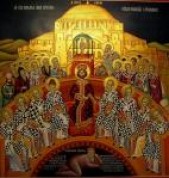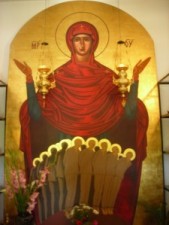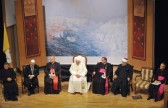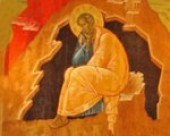You are currently browsing the daily archive for April 10, 2010.
The Church of Our Most Pure Mother Theotokos from Blachernae is located in the city of Constantinople (today Istanbul capital of Turkey). This is the most famous and important church dedicated to Virgin Mary in the capital of Byzantium, after the Cathedral of Saint Sophia. Although today only few ruins are preserved from the initial church, the church from Blachernae remained alive in the consciousness of the Christian faithful that are always under the care of our most pure Mother.

The history of the Church of Blachernae, which had spread throughout the Christian world during the entire existence of the Byzantine Empire, shows us a very close connection between this church and the city of Blachernae.
The initial ancient church was built on the site of the Holy Spring fountain of the Virgin and later decorated by Empress Augusta Poulcheria between 450-453 and by her husband, Emperor Marcian (450-457). Because of Empress Augusta’ death, the church was left unfinished, but it was continued by her successors.
.jpg)
The church was completed by Emperor Leo the I (457-474), which added “Hagiasma ” (the fountain of Holy Water) and “Hagion Lousma” (the holy bath for the priests). Leo the I also built the chapel “Hagia Soros”, a special relicvar designed to keep inside “The Veil of the Mother of God” that was brought to Constantinople from Palestine, in the year 473.
Over the years, the Byzantine emperors showed their interest and devotion towards the church, making numerous donations in cash and ornaments.
.jpg)
Procopius writes that Emperor Justinian, during the reign of his uncle, Justin the I (518-527), expanded the initial building. Procopius’s description suggests a dome was added, supported by several columns shaped in semicircle. This renovation is mentioned also in two epigrams of the Palatinian Anthology.
.jpg)
Justin the II (565-578) added two lateral apses, thus reshaping the initial plan of the church. Several centuries later, Argyrus Romanus the III (1028-1034) decorated the apse with gold and silver.
Emperor Heraclius in one of his chronicle, mentioned that the church was served by 74 clergymen: 12 priests, 18 deacons, 6 diaconates, 8 sub-deacons, 20 reader, 4 singers and 6 goalies.
.jpg)
One of the most important event in the history of this church took place in 626, when the city of Constantinople was besieged by Avars while the Emperor Heraclius and his troops were gone to fight the Persians in Asia Minor. The Icon of the Theotokos = Blachernitissa was taken up in procession on the battlefield by the Emperor’s son and the Patriarch Sergius (610-638). The Avars stopped the battle, and this victory is placed all to the account and protection of the Holy Virgin Mary. The entire population of the town gathered at the Church of Blachernae, spending all night in vigil and singing praises to the Mother of God.
Similar to the great Cathedral of Saint Sophia, this church was the center of Orthodoxy in Constantinople and, every Friday an all-night vigil was observed here, in honor of the miracle-working icon of the Mother of God.
During the iconoclastic period and especially during the reign of Emperor Constantine the fifth, the church of Blachernae called also Panagia of Blachernae had its entire iconography – that conferred the church a lot of beauty – destroyed.
.jpg)
In a work (written in 808) about the life of St. Stephen the Young, it is recorded that the iconoclasts had replaced the icons of our Saviour, of the Virgin Mary and of the saints, with pagan representations of trees, birds and animals.
In 834, when the iconoclasts were put to shame, the “Sunday of Orthodoxy” was celebrated for the first time – also called by the Holy Father – the Sunday of Restoration of the cult of the Holy Icons. Thus, it’s very first celebration was held in the Church of Blachernae.
The Holy Tradition also notes that, in the year 944, the Image of Christ known as “Holy Veil”, and a letter of King Abgar, were brought from Edessa and placed with great reverence in the church chapel.
.jpg)
Many testimonies preserved until today about the Church of Blachernae, also mention that many Emperors of the Byzantine Empire would take with them during their campaign battles, a relic of the icon of the Mother of God. Also, many imperial seals bore the sign of this church – Blachernitissa.
.jpg)
Staring with 1204, the church was taken up by the Latins (Romans), until the time of the Emperor John the III – Doukas Vatatzes (1222-1254) of the Empire of Nicaea, when he recovered the church, along with many other monasteries of Constantinople. In 1347, Emperor John the VI (Cantacuzinos) was crowned in the Church of Blachernae, instead of being crowned in the Cathedral of Aghia Sophia, as it was customary.
After a fire (in 1070) had destroyed the church, it was rebuilt by the Emperors Romanus IV Diogenes (1067-1071) and Michael VII Doukas (1071-1078).
However, in 1348, the Genoese pirates invasion had caused even more damage to the church
.jpg)

After the conquering and the Fall of Constantinople, the beautiful church of Blachernae was totally destroyed and only the Holy Spring of the Virgin was left. This place remained in the possession of the Turks until 1867, when it was given to the Greeks, who built a little church – Hagiasma in the place of the ancient church. The Ecumenical Patriarchate undertook great efforts to reconstruct the initial church and make it look as we know it today. In this little church, the four scenes painted by Eirenarchos Covas in 1964 on the wall above the fountain, remember us the great battles the Church of Blachernae undergone throughout history.

The icon of the Virgin Mary: “The Intercessor “
The disappearance of the old Icon of Our Lady painted on wood and covered with gold and silver, is believed that it took place during the iconoclastic period. According to the tradition, the icon was found later hidden behind a wall, in the year 1030, when Emperor Romanus the III: Argyrus renovated the church.


This icon stands in close connection with the miracle of the Mother of God committed when often taken out in procession, as shown in the writings of Anna Komnene.
In the year 911, Constantinople was surrounded by enemies and the people gathered in the Church of Blachernae asking our blessed Mother for help. The church was decorated for its usual Friday night vigil. Saint Andrew the “Fool for Christ” was there, along with his disciple, Epiphany.
Around 4.00 AM that morning, St. Andrew and Epiphanus saw a vision of the Blessed Virgin Mary, who passed through the doors of the church, accompanied by St. John the Baptist, Saint John the Theologian, and many angelic hosts.
The Holy Virgin stopped in the middle of the church under the central chandelier, knelt and began to pray with tears to Her Son. Then she entered the Holy Shrine and prayed again. Then she uncovered her head and placed her precious veil over the whole Church of Blachernae, while she was raising up high (into Heaven). This event is honored by the Orthodox church on October 1.
Through the prayers of our most pure Mother Theotokos, Lord Jesus Christ have mercy on us. Amen!
Reading from the Synaxarion (July 2nd):
During the reign of Leo the Great (457-474) two patricians and brethren on a pilgrimage to the Holy Land lodged with an old widow, a Christian of Jewish descent. Seeing the many miracles wrought at a small shrine in her house, they pressed her until she revealed to them that she had raiment of the most holy Theotokos kept in a small coffer. Our Lady had had two virgins in her lifetime who attended upon her; before her holy dormition, she gave each of them one of her divine garments as a blessing. This old widow was of the family of one of those two virgins, and it had come through the generations into her hands.
With the permission of God, that this holy relic might be had for the profit of many, the two men took the garment by stealth and brought it to Blachernae near Constantinople, and building a church in honor of the Apostles Peter and Mark, they secretly enshrined the garment therein. But here again, because of the multitude of miracles that were worked, it became known to the Emperor Leo, and a magnificent church was built, as some say, by that same Leo, but according to others, by his predecessors Marcian and Pulcheria, and enlarged by Leo when the holy raiment was found. The Emperor Justin the Younger completed the church, which the Emperor Romanus IV Diogenes raised up immediately again after it had burned in 1070. It burned again in 1434, and from that time it remained a small house of prayer together with the renowned holy spring.
After the seventh century, the name Blachernae was given to other churches and monasteries by their pious founders out of reverence for this famous church in Constantinople. In this church John Catacuzene was crowned in 1345; also, the Council against Acindynus, the follower of Barlaam, was convoked here (see the Second Sunday of the Great Fast).


 Christian Dogma
Christian Dogma Christian Martyrs
Christian Martyrs Christian Orthodox Churches and Monasteries
Christian Orthodox Churches and Monasteries Christian Sermons and News
Christian Sermons and News Church's Teachings on Fasting
Church's Teachings on Fasting Ecumenism – a Great Heresy
Ecumenism – a Great Heresy Father George Calciu
Father George Calciu Life_a Sacred Gift form God
Life_a Sacred Gift form God Orthodox Saints and Church Fathers
Orthodox Saints and Church Fathers Spiritual Elders
Spiritual Elders Daily Bible Readings
Daily Bible Readings Journey to Orthodoxy
Journey to Orthodoxy Listen to Ancient Faith Radio
Listen to Ancient Faith Radio Orthodox Calendar of Feasts and Saints
Orthodox Calendar of Feasts and Saints Orthodox Christian Mission Center
Orthodox Christian Mission Center Orthodox Institute
Orthodox Institute OrthodoxChristianNetwork TV
OrthodoxChristianNetwork TV
Recent Comments